Using data for better farming: Advances in agroinformatics
Desmond Thompson
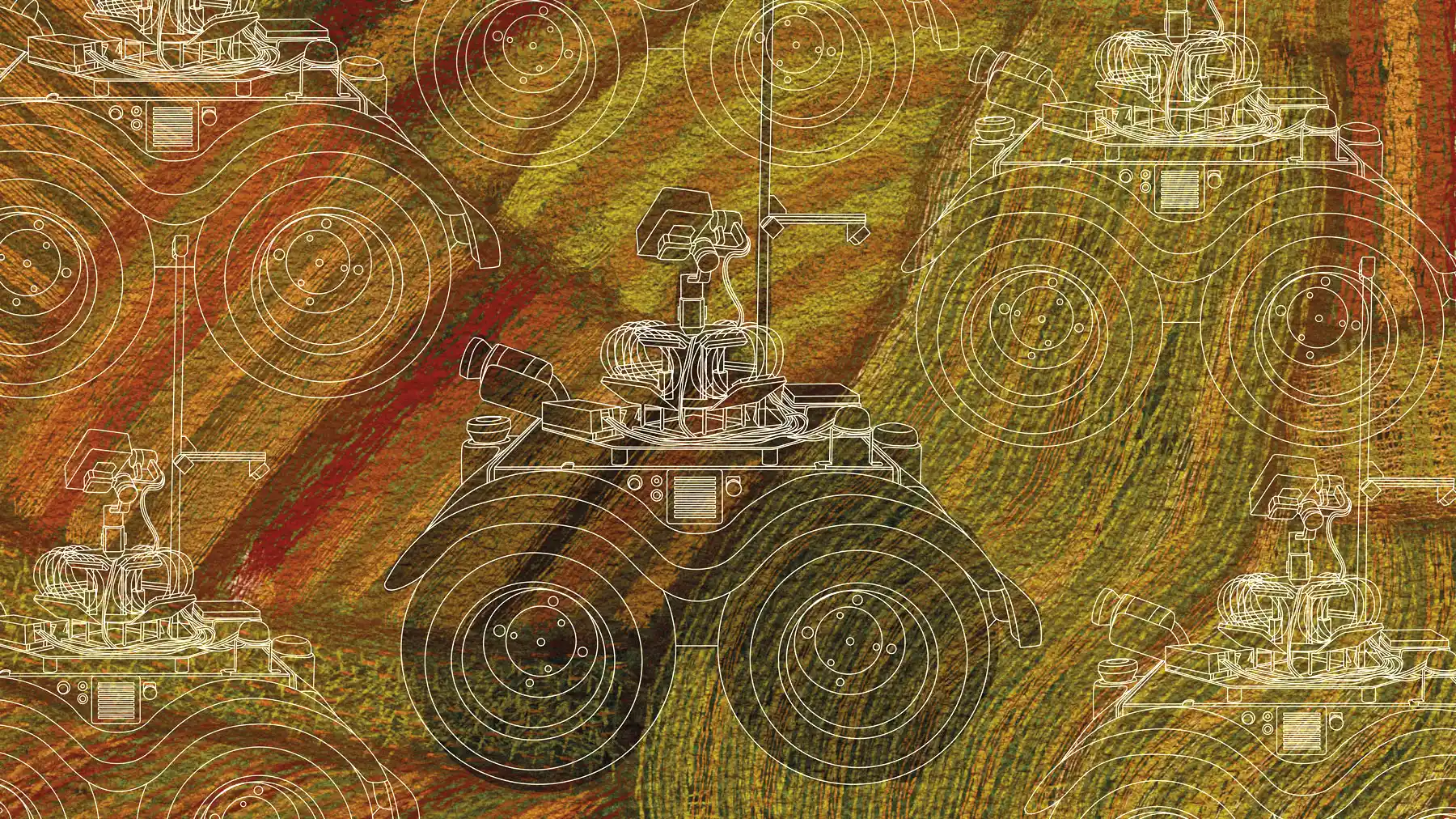
Agroinformatics as a scientific discipline constitutes the ‘what and why’ behind the use of data and technology in agriculture. | Illustration by Ronel van Heerden
For some time now, big data has held the promise of having a revolutionary impact on various sectors of society that will lead to better, faster decision-making, improved processes, and ground-breaking discoveries.
In agriculture, better data management, analysis, and application can boost animal and crop improvement, biosecurity and disease control, postharvest technology, agroprocessing, value chain analysis and development, as well as food sustainability and security. It can also help counter and build resilience to climate change.
Data for food security
A closer look at just one of these aspects — food security — clearly illustrates why data is considered a game changer.
In compiling the Food Waste Index Report 2024, researchers found that the world squanders over a billion meals a day, amounting to almost a fifth of all food available to consumers.
Inger Andersen, executive director of the United Nations Environment Programme (UNEP), describes this as a “global tragedy” because, this wastage notwithstanding, nearly 800 000 people go hungry daily and a third of humanity faces food insecurity.
The agricultural sector has an important role to play in addressing this problem. Dr Jan Greyling, a senior lecturer in the Department of Agricultural Economics at Stellenbosch University (SU), says: “It’s a massive task to feed a global population of eight billion people three times a day, and that responsibility falls to agriculture.”
Greyling believes that big data analysis can improve food availability, access, and utilisation, among other things. However, this potential is not yet being fully realised, he says.
“Big data can change the world, but it’s gushing at us like water from a firehose, and we’re not actually making sense of it. We need to look at it differently. We must move from numbers to actionable insights.”
Revolutionary impact
The statistics on big data are truly staggering. According to trends monitor Exploding Topics, around 329 million terabytes of data are created every day.
Considering that an estimated 90% of the world’s data was generated in the last two years alone, data generation is expected to continue increasing at an exponential rate as the Internet of Things (IoT) and new developments in artificial intelligence (AI) expand humanity’s digital footprint.
According to the United Nations’ Food and Agriculture Organization, big data analysis is revolutionising agriculture. The use of digital technologies — including smartphones, tablets, sensors, drones, and satellites — has become common in the sector, providing a range of farming solutions, from the remote measurement of soil conditions to real-time livestock and crop monitoring.
“There’s lots of technology in agriculture and forestry — autosteering tractors connected to satellites and lately to the internet, machines going through orchards and counting fruit, drones spraying crops and taking high-resolution images, etc.,” Greyling says.
“But these technologies are all things we can physically see and touch. What’s not so visible is the constant stream of data that they produce. We’re not fully exploiting that yet.”
Greyling has a specific challenge for the research community: “We need to view the data in itself as an asset, something valuable to invest in and not just to be written up in a thesis or journal article and then to be dumped in an obscure repository where it is ostensibly available to others. Only once we start combining existing stores of big data in new ways and analyse it properly, agroinformatics will really change the world.”

Prof Danie Brink | Photo supplied
A big data initiative
Prof Danie Brink, the dean of AgriSciences at SU, has placed agroinformatics at the heart of his faculty’s research and innovation strategy.
As such, one of its new projects focuses on changing the way in which big data is integrated into agriculture and forestry research. It’s called the ‘Stellenbosch Agroinformatics Initiative’ (SAI) and is aimed at enabling data-intensive interdisciplinary research and innovation partnerships that span departments, faculties, universities, companies, and continents.
Greyling, head of the SAI, says: “Effective data management, sharing, and collaboration across disciplines are crucial components of research that can make a meaningful impact on society and the agricultural sector.”
The Faculty’s vision with the SAI aligns with the national Department of Science and Innovation’s (DSI’s) Decadal Plan 2022–2032, a policy tool developed to help implement the country’s 2019 White Paper on Science, Technology, and Innovation.
Collaborating for maximum impact
Greyling says calling the project an ‘initiative’ was a deliberate choice.
“We could have established a standalone centre or institute in the Faculty, but that might have sidelined data science, which would have been counterproductive.
“Instead, we want to make data science a part of every department and research group in the Faculty because the management, analysis, and utilisation of data have become integral to all our work.”
The SAI’s positioning alongside academic departments in the Faculty is similar to what the University as a whole did when it established the School for Data Science and Computational Thinking in 2019. It was positioned alongside faculties to facilitate collaborative approaches to teaching and research in data science across the University. The SAI has partnered with the School and collaborates closely with it.
In the words of Prof Kennedy Dzama, the Faculty’s Vice-Dean for Research, Innovation, and Postgraduate Studies: “It is intrinsically valuable to share information and ways of thinking. Different universities and entities within them will have different strengths, but they can complement each other through collaboration.”
An aspect of collaboration highlighted by Brink is the interdisciplinary coordination of research. The SAI brings researchers from different academic fields together to establish communities of practice around five core data-intensive research techniques: image processing, LiDAR (light detection and ranging), the IoT, special analysis, and genomics.
“The challenge is to bring domain experts from different fields together, combining their expertise to solve the major challenges facing the agri-food and natural resources sectors,” says Greyling.
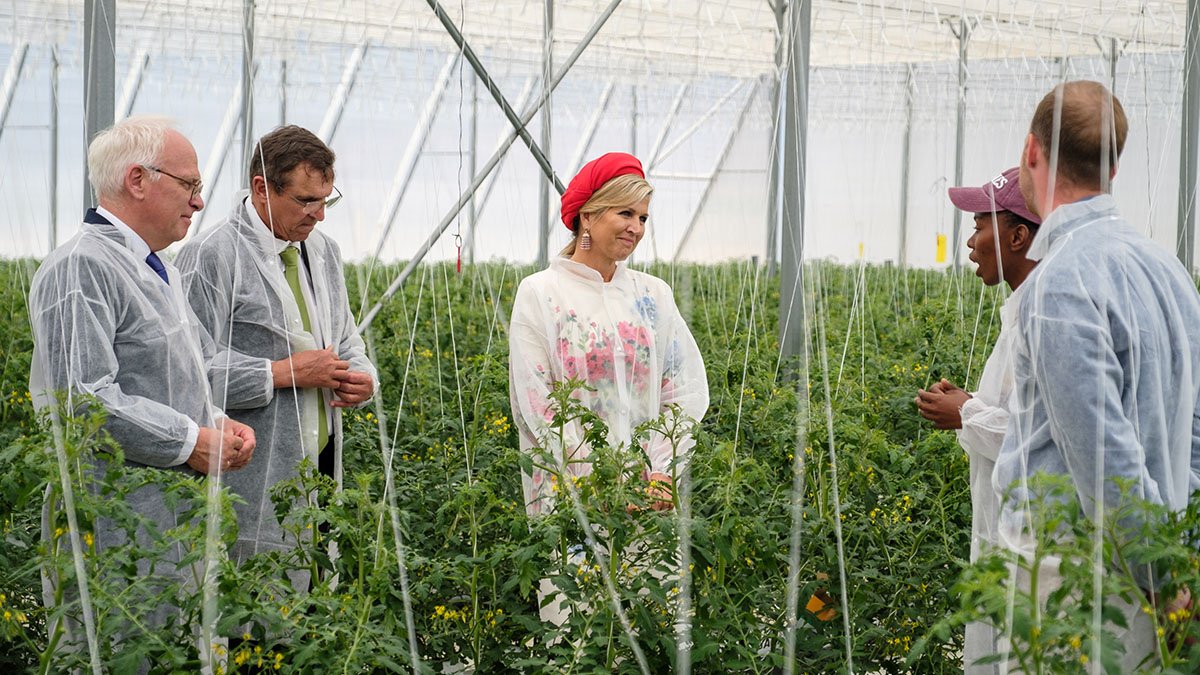
Queen Máxima of the Netherlands receives a briefing during a visit in 2023 to SU’s HortiDemoCentre, a facility erected with Dutch co-funding to demonstrate the advanced greenhouse technology developed in that country. The Netherlands is a key case study in agricultural technology and innovation, it being the fourth largest food exporter in the world, despite its limited arable land. | Photo by Stefan Els
Agroinformatics: The science
Agroinformatics as a scientific discipline constitutes the ‘what and why’ behind the use of data and technology in agriculture.
Practitioners in this field focus on collecting agricultural data from various sources such as sensors, satellites, and weather stations. This data is then analysed to gain insights that can improve farming practices.
Agtech: The tools and applications
Agricultural technology or ‘agtech’ refers to the practical application of the scientific advancements made in agroinformatics. Essentially, this is the ‘how’ part of using agricultural data and technology.
Agtech companies use the data and insights from agroinformatics to develop tools and technologies for farmers. Examples include:
- variable rate technology for the more accurate application of fertiliser and water;
- robotics for the automation of farm tasks;
- sensors and software to monitor crop health and soil conditions; and
- online platforms for farmers to connect with buyers and sellers.
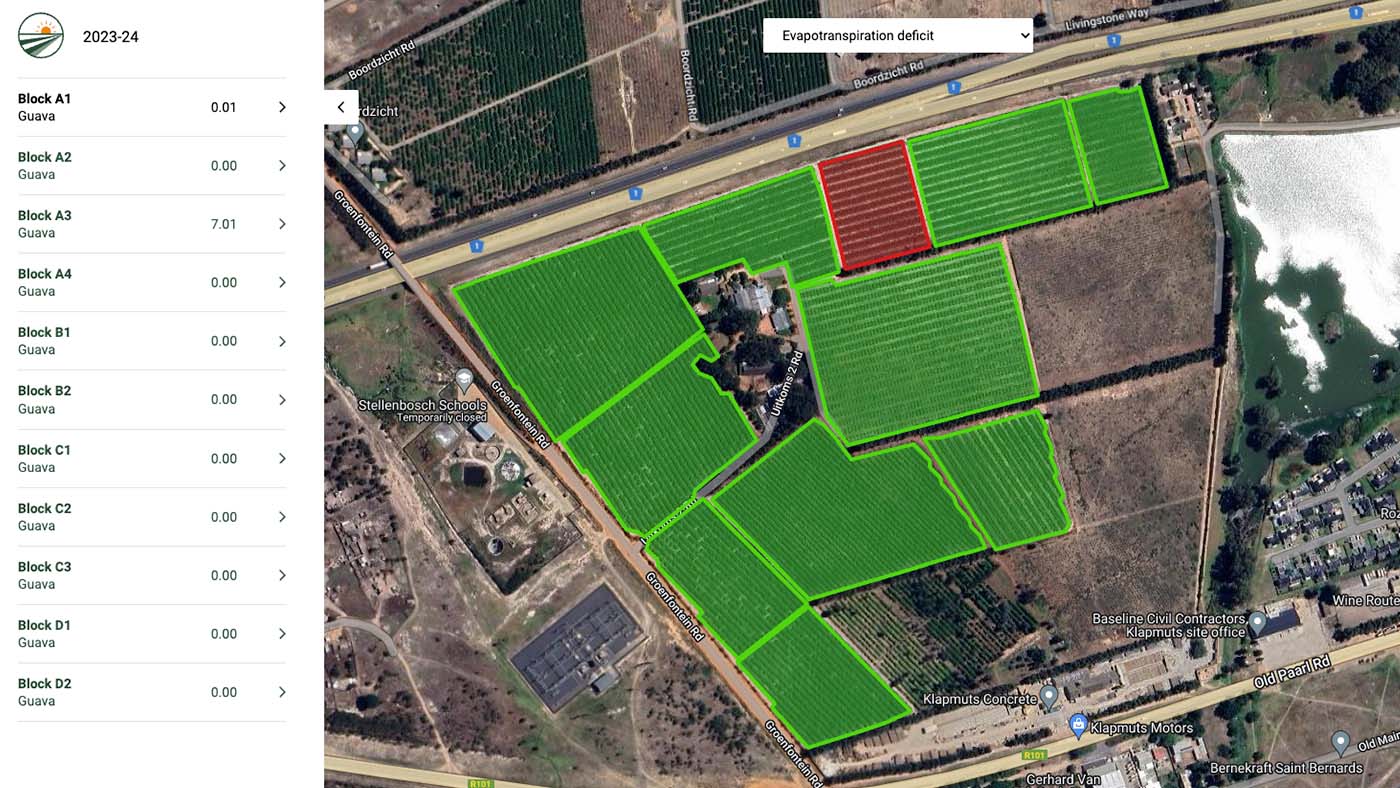
A screenshot of an application freely available on the Fruitlook website, showing the moisture content of guava orchards near Stellenbosch. | Image courtesy of Fruitlook
Agtech in practice
According to Suné van Zyl, who used the Western Cape Department of Agriculture (WCDoA) as a case study in her master’s thesis on using big data in the public interest, the use of technology in agriculture is known as ‘agtech’ or ‘Agriculture 4.0’.
“Vast information sets generated by remote sensing technologies such as drones, satellites, soil monitors, and infrared sensors can produce a multitude of insights into weather and land conditions,” she says.
“This sort of information can inform and guide farmers in monitoring the productivity of their land, anticipating disasters such as droughts, and choosing crops that best suit the specific conditions of their land.”
In this way, farming informed by big data “can increase productivity, reduce waste, and assist farmers in monitoring the conditions of their resources.
“Furthermore, such insights can assist the sector in pre-empting land degradation and desertification, and ultimately enhance the sector’s resilience against climate change and related disasters.”
One example of an application that is making big data accessible to farmers is Fruitlook, funded by the WCDoA. It is free of charge to all role players in the sector and is used to inform operations and management decisions relating to irrigation, scheduling, and crop production.
This big-data-driven farm management tool takes the form of a web-based portal that provides the agricultural sector of the province with near-real-time data on the growth as well as moisture and mineral content of their crops.
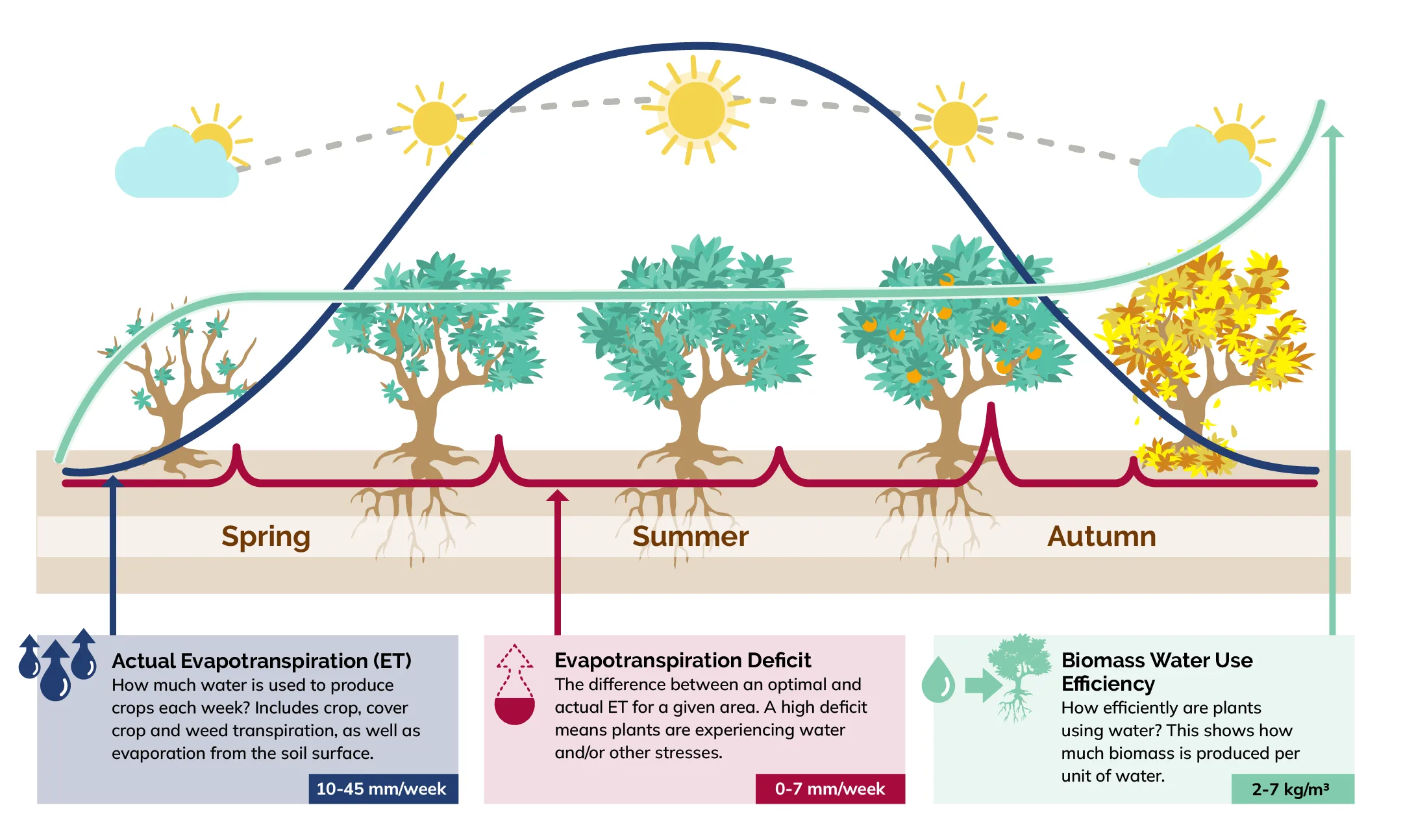
An infographic on Fruitlook's website. | Image courtesy of Fruitlook
Image processing
In the SAI’s image processing community of practice, Prof Lizel Mostert of the Faculty’s Department of Plant Pathology is using AI to help with the identification of plant disease symptoms.
“Grapevine leafroll is an economically devastating disease for grapevine producers in South Africa,” she says.
“To ensure clean propagation material, it is essential to identify diseased vines. But that’s easier said than done as it can be quite hard to distinguish infected leaves from ones that have been mechanically damaged or are suffering from a phosphorus deficiency.”
This fact has led to a study aimed at developing an AI-based system that uses deep learning techniques to identify leafroll-infected vines via photos taken with a smartphone.
In typical interdisciplinary fashion, this research is being conducted in collaboration with SU’s School for Data Science and Computational Thinking, Department of Industrial Engineering, and South African Grape and Wine Research Institute (SAGWRI).
The study is being funded by South Africa Wine, the national body representing wine grape producers, cellars, and wine-related businesses and wholesalers in South Africa.
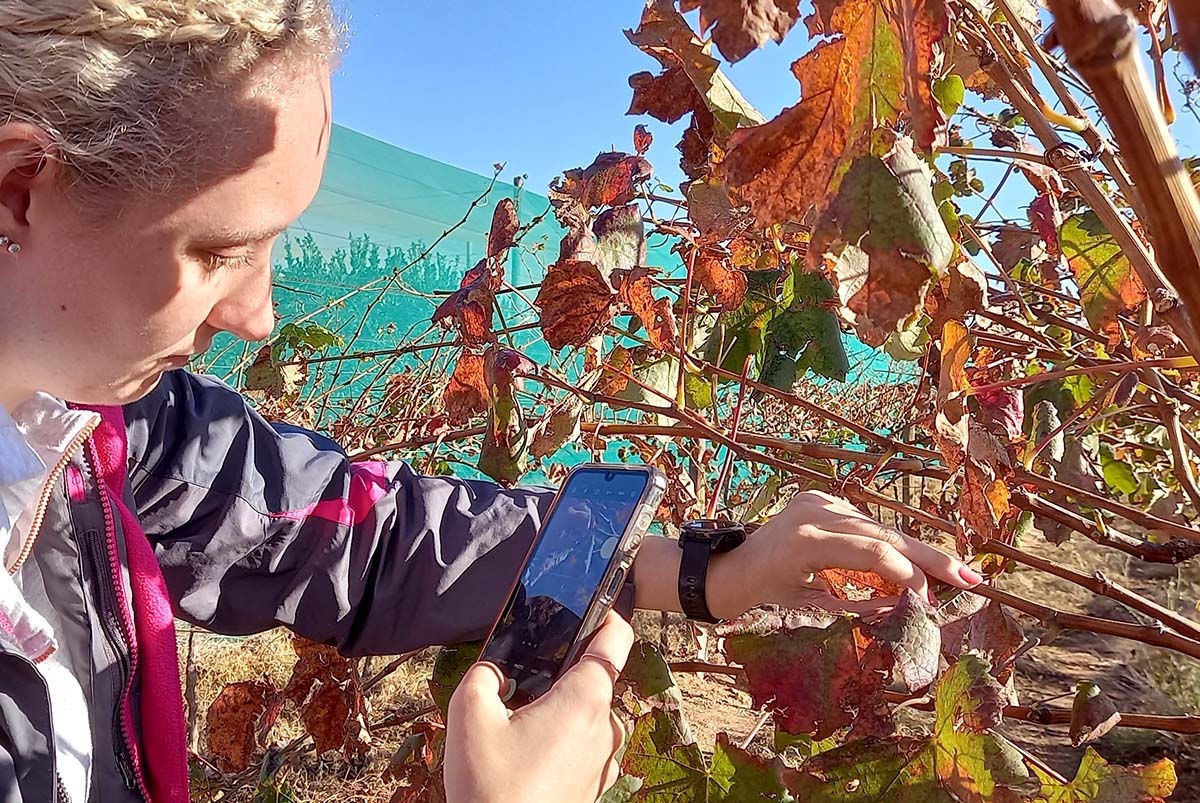
Elsefie Fouché, a BSc Hons student at SU, takes a photo with a smartphone in a vineyard as part of a research project to develop an AI-based system using deep learning techniques to identify leafroll. Leaves of these vines were used to include examples of a cultivar that naturally turns red in autumn. | Photo by Dr Beatrix Coetzee

AI-powered, automated image analysis would be able to distinguish between a leafroll-infected leaf (photo A above), red discolouration caused by mechanical damage (photos B and C), and a phosphorus deficiency (photo D). | Photos supplied
Hyperspectral imaging
While field analysis on the go is useful, more extensive investigation is sometimes necessary. It is then that the HySpex hyperspectral imaging system comes into its own.
Housed in the Faculty’s Department of Food Science, this system is used in plant pathology studies, as well as food chemistry and microbiology research. It lies in the capable hands of Dr Paul Williams, a data scientist and spectroscopy expert in the Department.
Hyperspectral imaging is a technique that combines digital imaging with spectroscopy to capture and analyse reflected light across hundreds of spectral bands, Williams explains.
While our eyes typically perceive only the colours red, green, and blue, hyperspectral imaging captures a much broader range of the electromagnetic spectrum, thereby providing a very detailed picture of an object.
Hyperspectral snapshot cameras enable the real-time inspection of crops for the early detection of disease and water stress, and for the analysis of soil quality.
“Hyperspectral imaging is fast, accurate and allows samples to be analysed non-destructively and non-invasively with minimum or no sample preparation,” Williams explains.
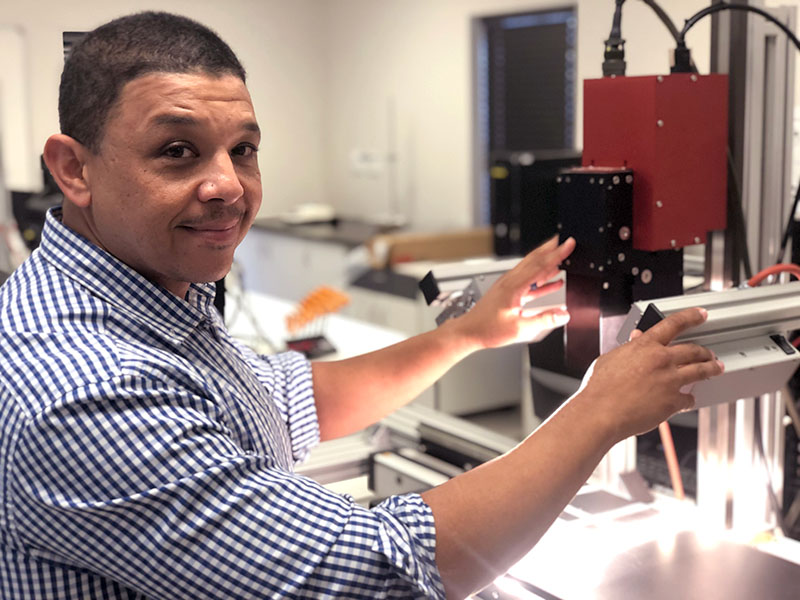
Dr Paul Williams next to SU’s hyperspectral imaging system. | Photo by Desmond Thompson
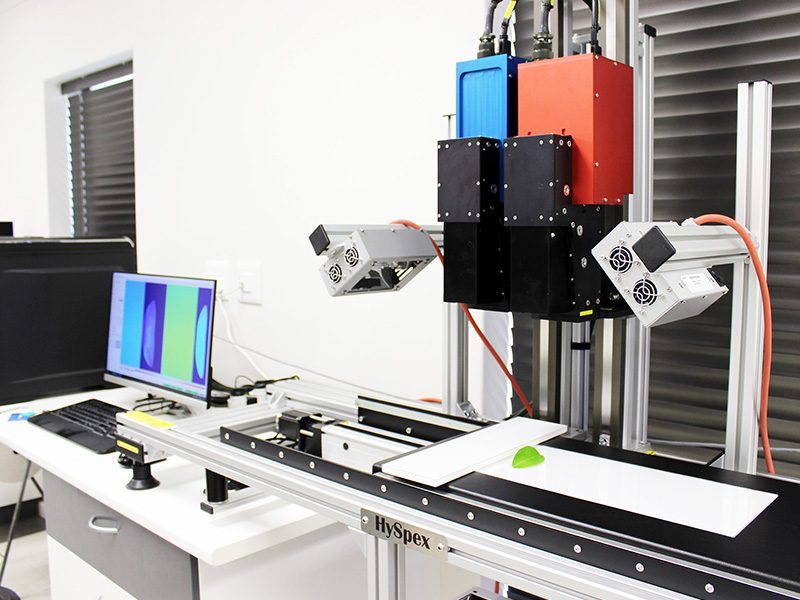
SU’s hyperspectral imaging system can be used to acquire spectra of samples in the visible near-infrared and shortwave infrared wavelengths. | Photo supplied
Smart farming for the future
Non-invasive technologies also feature prominently in another of the Faculty’s communities of practice, namely the one focused on the IoT.
The latter consists of sensor-embedded devices that share data with each other and with analytic systems via the internet or other communication networks.
The IoT is transforming agriculture into a more data-driven and efficient practice, often referred to as ‘precision agriculture’ or ‘smart farming’. Producers using this technology can gain a deeper understanding of their farming environment, which allows them to optimise their operations.
Prof Carlos Poblete-Echeverría coordinates SAGWRI’s research group on digital agriculture, which is based on the principles of smart farming. In a keynote address presented at the 10th International Table Grape Symposium in Somerset-West at the end of 2023, he argued that table-grape growers stand to benefit from the latest advances in data collection and processing.
“We are looking at a group of new technologies — sensors, platforms, algorithms and the like — that can be used to provide useful information for optimising management practices in viticulture and the broader field of agriculture,” he says.
Data acquisition is the first step in digital viticulture, he reckons. Of the many non-invasive technologies available for use in sensors, the most familiar is digital photography based on visible light.
“There are plenty of applications for simple cameras, especially when you attach them to a drone or vehicle. You can also use time-lapse photography. Normal cameras are a great low-cost technology.”
Other digital imaging technologies such as spectroscopy, multi- and hyperspectral imaging, and infrared thermography rely on non-visible light.
Besides light-based sensors, there are also sensors that detect electrical resistance and conductance for use in soil analysis.
‘Robots are coming’
For sensors to collect data from a whole vineyard, they must be mounted on observational platforms such as satellites, manned or unmanned aircraft, ground-based vehicles, or robots.
According to Poblete-Echeverría, drones represent a radical shift for aerial sensors. “We are almost at a moment where unmanned aerial vehicles are fully automatic, and we can have excellent resolution with the images we obtain.”
Ground-based sensors, on the other hand, can be mounted on tractors or quad bikes and linked to global positioning systems to obtain accurate spatial data.
“Robots are coming — it’s certain that they will soon be used to perform specific tasks and capture information,” says Poblete-Echeverría.
Already, SU’s Department of Viticulture and Oenology has collaborated with South Africa’s Council for Scientific and Industrial Research (CSIR) to implement a prototype robotic platform specifically designed for vineyards. Called ‘the Dassie’, the robot trundles up and down the work rows, carrying a suit of sensors to collect data about each vine it passes. This information is fed to a computer programme to evaluate aspects such as canopy growth or the temperature and humidity around leaves and grape bunches.

Drones are becoming an increasingly important tool in agriculture, helping farmers to monitor crop health, apply pesticides and fertilisers more precisely, and improve yields. | Photo supplied
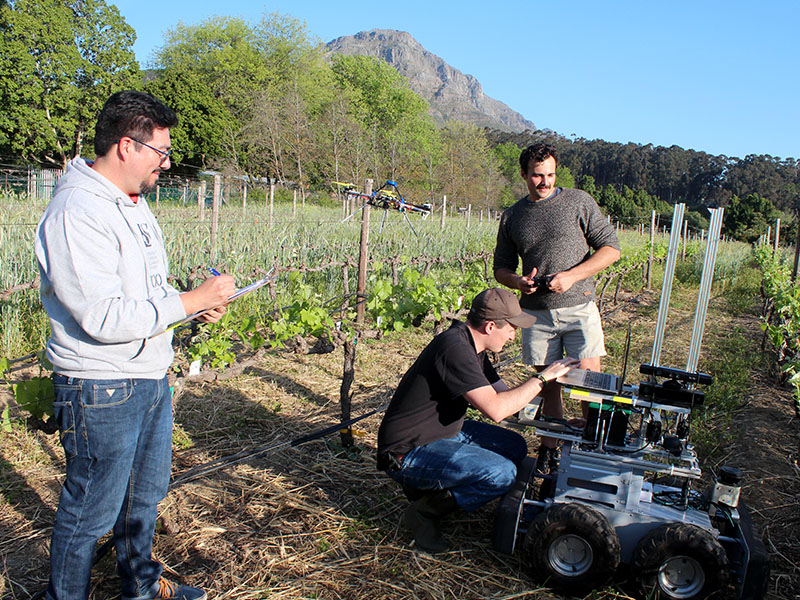
Prof Carlos Poblete-Echeverría, left, with two of his students using a drone and “the Dassie”, a robotic platform designed for vineyards. | Photo supplied
AI in agriculture
Increasingly, AI is used to comprehend the data extracted from sensors that are based on observational platforms. Computers are trained to simulate human reasoning to draw conclusions from data.
“Today, AI is a hot topic. It’s amazing what we can do with it,” says Poblete-Echeverría.
He is confident about the value of new technologies, but cautions that AI “is not magic.
“We need to follow certain steps to produce correct models, and models should be trained and tested properly before being released to the market.”
‘Two agricultures’
In a recent op-ed in Business Day, Wandile Sihlobo, chief economist of the Agricultural Business Chamber of South Africa and a senior fellow in SU’s Department of Agricultural Economics, points out that the country’s agriculture sector has “grown tremendously” over the past 30 years.
Domestic agricultural output in 2022/23 was twice as high as in 1993/94, with the result that, in 2022, South Africa was the world’s 32nd largest agricultural exporter — the only African country in the top 40 in value terms, according to data from Trade Map. South Africa now exports about half of its agricultural production in value terms, having reached a record worth of $12.8 billion (R371.6 billion) in 2022.
Sihlobo highlights new production technologies and better farming skills as two of the main reasons for the country’s increased production levels.
However, he argues that “the gains we’ve seen in agricultural production […] have not been equitably distributed across the agricultural industry.”
In his recent book, A Country of Two Agricultures, he argues: “On the one hand, we have a subsistence, primarily non-commercial and black farming segment; on the other, we have predominantly commercial and white farmers.
He insists that we must never be complacent with this dualism, and that the “task before us is [determining] how to keep growing the sector in a more inclusive and transformative manner.”
Modernising agriculture
One way to do this, according to the DSI’s Decadal Plan 2022–2032, is by modernising agriculture through science, technology and innovation (STI).
To achieve this, the plan says attention should be given to technological services, transdisciplinary and multi-institutional STI interventions aimed at agricultural intensification and new knowledge products, as well as technology transfer and adoption.
The hope is that this will result in precision agriculture, digital capabilities to modernise the sector, and more farmers ultimately becoming commercialised.
In a similar vein, South Africa’s Agriculture and Agro-processing Master Plan, adopted in 2022, lists enhancing competitiveness and entrepreneurial opportunities through technological innovations, infrastructure development, and digitalisation as one of its objectives.
Bridging the gap
The two agricultural segments described by Sihlobo are linked to the notion of a ‘digital divide’, which is evident in today’s information society. This divide refers to the gap between individuals and communities that have access to information and communication technologies, and those that don’t.
Factors contributing to the divide include access to devices such as smartphones and computers, internet availability and affordability, and digital literacy.
To have an impact on South Africa’s non-commercial farming segment, agtech applications should ideally be free of charge, require little data to access, and be easily accessible via the cell phones of subsistence farmers and community gardeners who might not have unlimited access to computers or the internet.
The WCDoA’s Fruitlook application is a good example in this case. Because it is free, not only “tech-savvy commercial producers but any farmer” stands to gain from it, Van Zyl says.
She points out that improved food security and safety is one of the WCDoA’s strategic priorities, which it pursues by trying to ensure increased access to food produced by communities and households.
Community and household vegetable gardens can boost the production of food for personal consumption, and Fruitlook can help in this regard because it is accessible to everyone.
Also, from an operational perspective, the provincial department can utilise big-data-driven technologies to monitor the performance of community gardens, track best practice initiatives, share information, and provide tailored support, Van Zyl writes in her thesis.
But, she also warns, “technology cannot be blindly put forth as the silver bullet that can solve deeply rooted systemic and cultural issues,” which brings us back to the Faculty’s agroinformatics initiative.
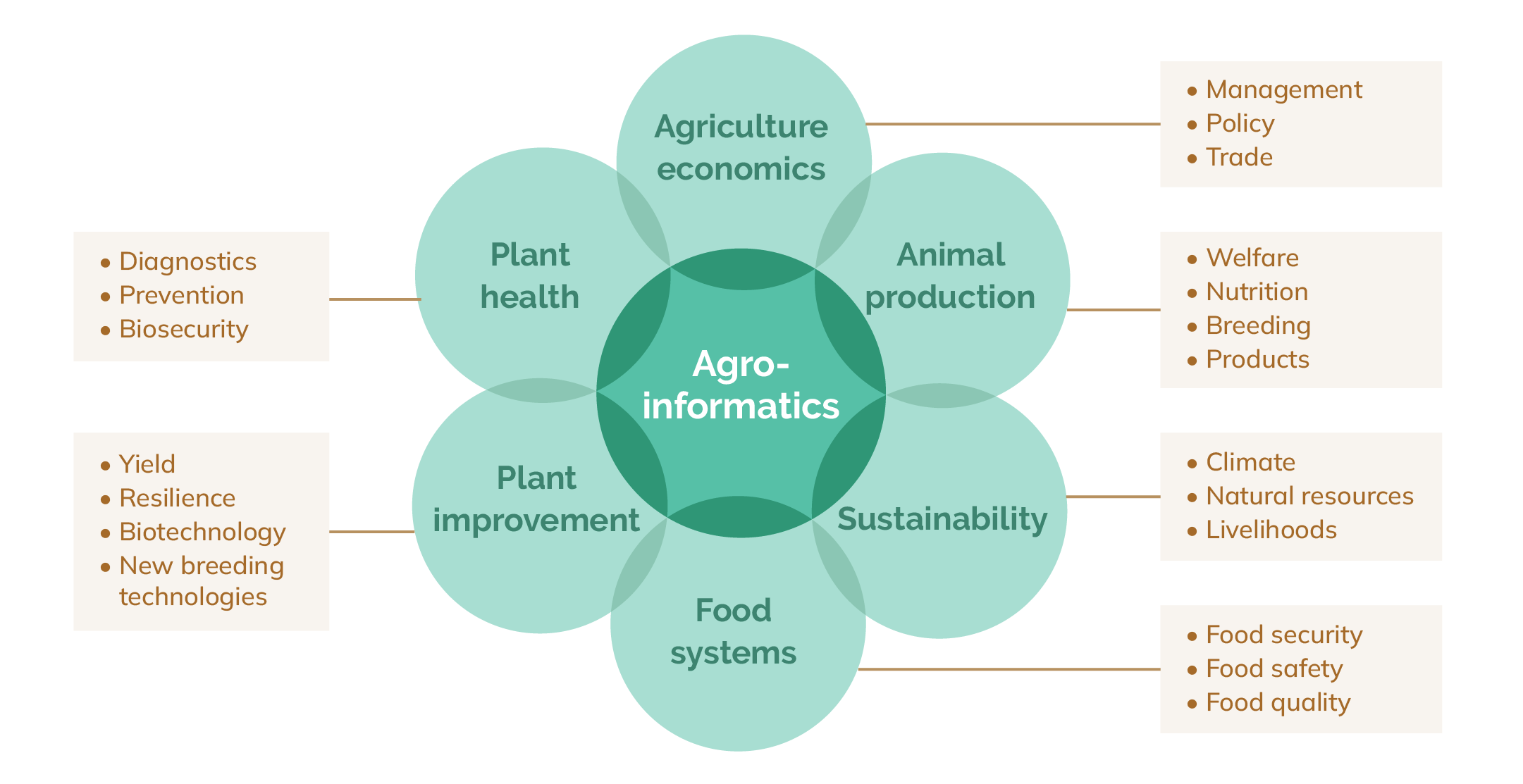
Agroinformatics is at the intersection of a range of cross-cutting research and innovation themes in the Faculty of AgriSciences: agricultural economics, animal production, sustainability, food systems, plant improvement, and plant health.
Tracking data from farm to fork
Big data is having a substantial impact on the agrifood sector, including specialised companies providing supply-chain solutions to the fresh produce industry. These companies use data to do real-time tracking, predictive analysis, and demand forecasting, thereby empowering their clients to manage risks and make informed decisions based on market insights.
One such company is AgrigateOne (AG1), a software enterprise with clients across the globe, founded by Greg Whitaker, a SU alumnus with a BCom degree.
“AG1 started because of supply-chain frustrations like inaccurate and manual processes, not knowing exactly where produce is at any point in time, and disparate software systems not speaking to each other,” says Charl van der Merwe, head of the data section at the company.
“A piece of fresh produce can travel thousands of kilometres across the world and get handled by tens of different entities. Food typically receives a 70% markup as it travels from farm to fork, but the original producers only receive a small portion of this income,” he explains.
Van der Merwe completed BSc and Honours degrees in Geoinformatics at SU, acquiring skills that he is now using in the agrifood industry.
“Data is at the heart of our business, that’s why our name is a play on data aggregation.
“We do data acquisition across disparate software systems at every step of the fresh produce supply chain, encompassing farming, land, and sea logistics.
“This aggregated data is made available to our clients and their trade partners via our cloud-based platform, enabling the smooth flow of produce through the supply chain.
“Our online platform offers growers and buyers transparency along the entire way. We provide data to track orders and shipments, and make informed decisions with the benefit of real-time notifications.”
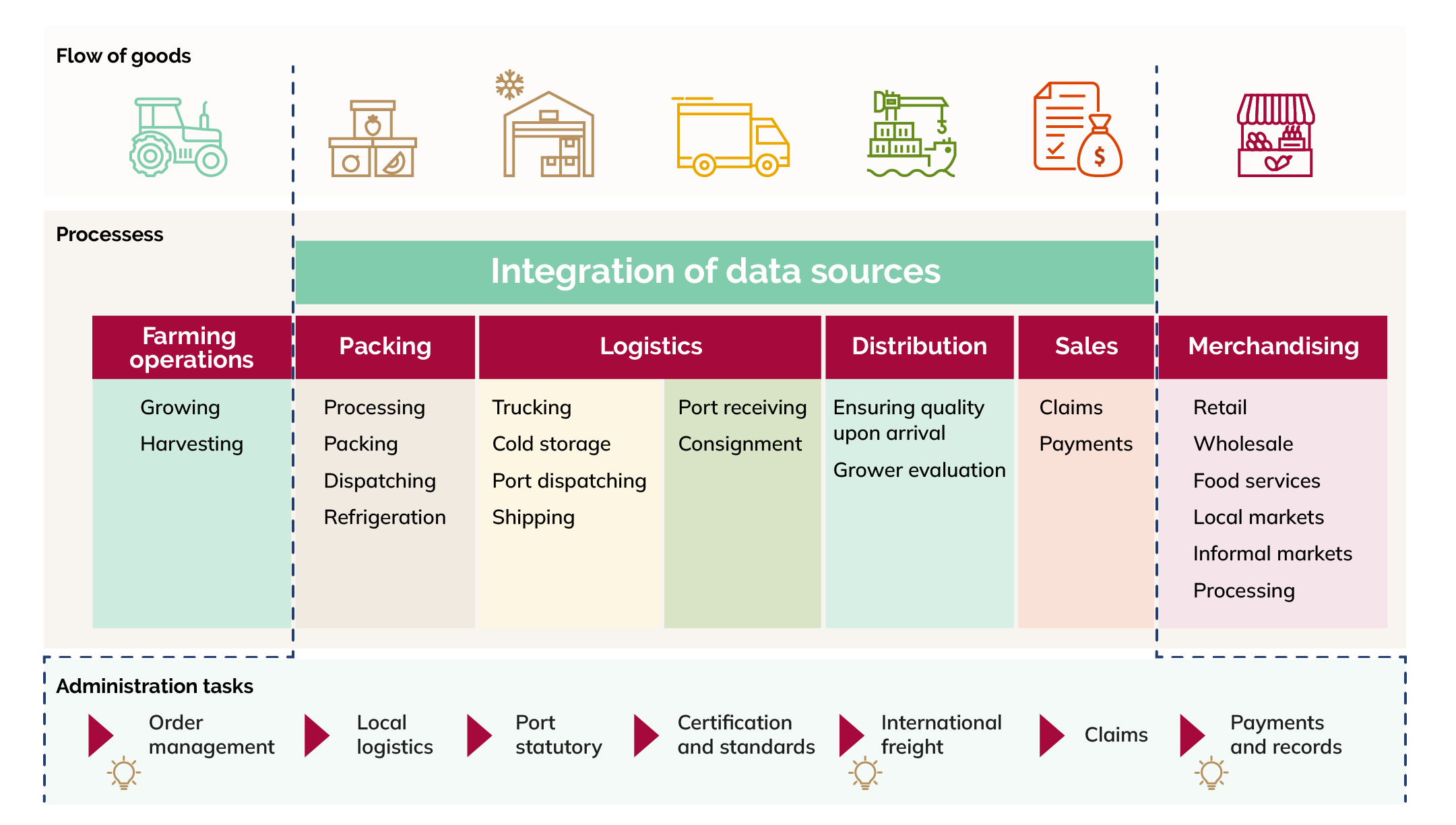
The integration of data sources along the agrifood supply chain. AgrigateOne operates between the dotted lines. | Image courtesy of AgrigateOne
Van der Merwe says supply chain improvements due to better data utilisation not only benefit food producers but ultimately also improve food security. This is vital, given that the global food demand keeps increasing, while an estimated 14% of all food is lost between harvest and retail. Improved resource management and waste reduction will promote greater sustainability.
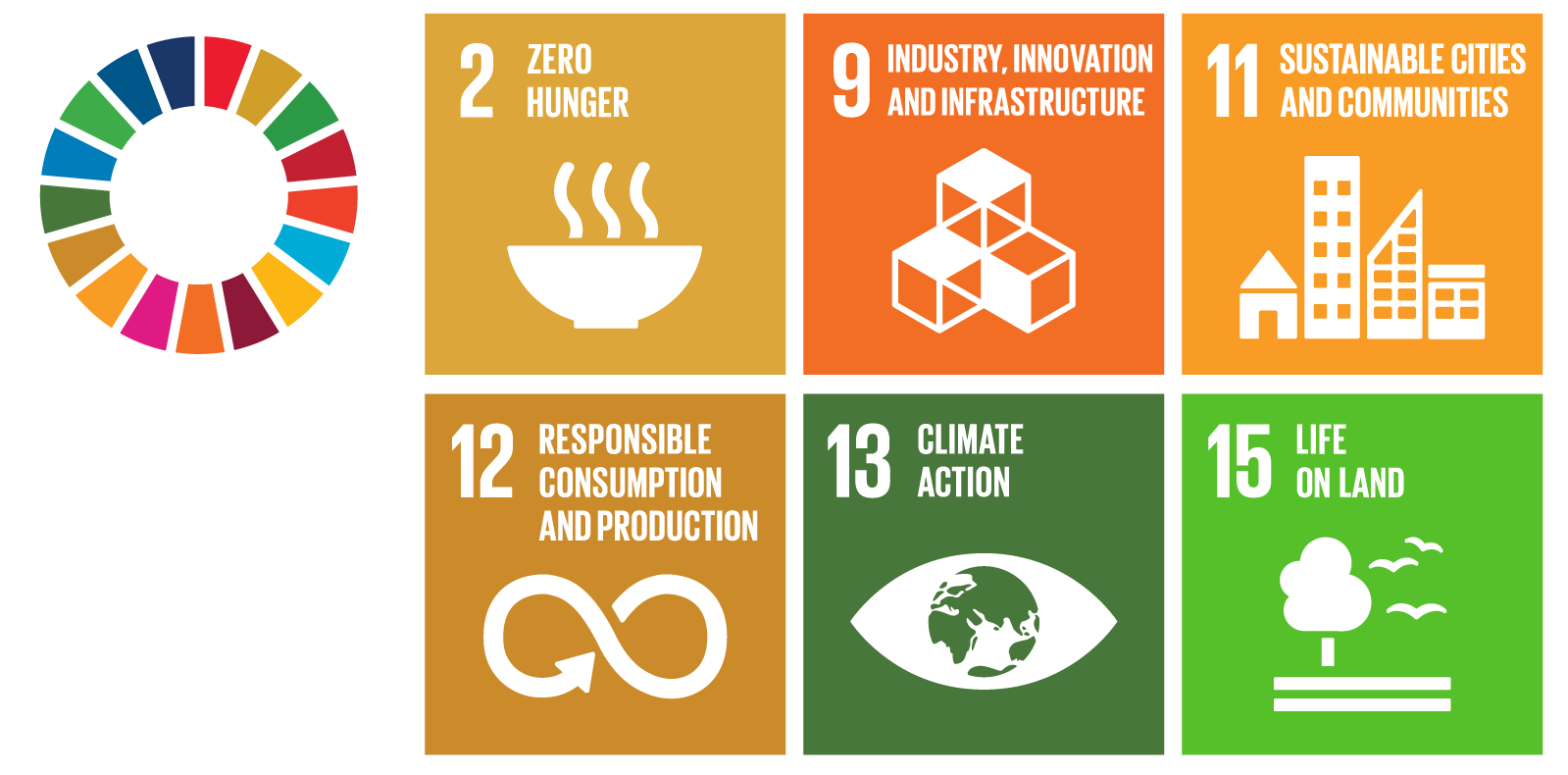
The research initiatives reported on above are geared towards addressing the United Nations’ Sustainable Development Goals numbers 2, 9, 11, 12, 13, and 15, and goals number 1, 2, 3, 4, 5, and 7 of the African Union’s Agenda 2063.
Useful links
SU's Faculty of AgriSciences
SU's Stellenbosch Agroinformatics Initiative (SAI)
South African Grape and Wine Research Institute (SAGWRI)
Western Cape Department of Agriculture (WCDoA)
Agricultural Business Chamber of South Africa
United Nations’ Food and Agriculture Organization
X: @MatiesResearch and @StellenboschUni